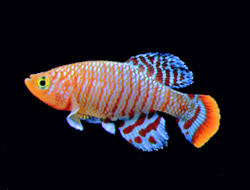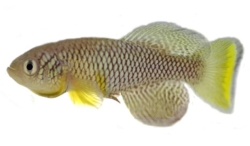Killifish
Killifish are a diverse group of oviparous (egg-laying) fish belonging to the order Cyprinodontiformes. Known for their vibrant colors and striking patterns, killifish are popular among aquarium enthusiasts. They inhabit a wide range of freshwater and brackish environments and are found in the Americas, Europe, Africa, and parts of Asia. The adaptability of killifish to various habitats is remarkable, with some species thriving in temporary water bodies that dry up seasonally.
Distribution and Habitat[edit | edit source]
Killifish are distributed across the globe, with the highest species diversity in the African and South American continents. Their habitats range from temporary ponds and swamps to streams and estuaries, demonstrating a broad ecological tolerance. Some species, such as the Nothobranchius genus, are adapted to survive in temporary waters by laying drought-resistant eggs that can remain dormant for months until water returns.
Biology and Ecology[edit | edit source]
The biology of killifish is as varied as their distribution. Most are small, with sizes ranging from 1 to 5 inches in length, although some species can grow larger. They exhibit a wide array of reproductive strategies, with some being annual fish that live for only a year. These annual species have evolved a fast growth rate and a short life cycle to take advantage of the ephemeral nature of their habitats.
Killifish diets are equally diverse, including algae, invertebrates, and smaller fish. Their feeding habits are closely tied to their environments, with different species having specialized diets based on the available food sources.
Conservation[edit | edit source]
While many killifish species are adaptable, they are increasingly threatened by habitat destruction, pollution, and climate change. Some species are considered endangered due to these pressures. Conservation efforts are crucial to protect these unique fish and their habitats, with some species being the focus of captive breeding programs to ensure their survival.
In the Aquarium[edit | edit source]
Killifish are prized in the aquarium hobby for their bright colors and interesting behaviors. They can be a challenge to keep due to their specific habitat requirements and often short lifespans. Breeding killifish in captivity requires careful attention to water conditions and egg incubation periods, especially for species that lay drought-resistant eggs.
Research Importance[edit | edit source]
Killifish have become important models in scientific research, particularly in studies of ecology, evolution, and toxicology. The Atlantic killifish (Fundulus heteroclitus), for example, has been extensively studied for its remarkable adaptability to polluted environments, providing insights into the mechanisms of environmental tolerance and adaptation.
Conclusion[edit | edit source]
Killifish represent a fascinating and diverse group of fish that play significant roles in their ecosystems. Their varied life histories and adaptations make them of great interest to scientists and aquarium hobbyists alike. Conservation of their habitats is vital for their survival, highlighting the need for continued research and protection efforts.
Search WikiMD
Ad.Tired of being Overweight? Try W8MD's physician weight loss program.
Semaglutide (Ozempic / Wegovy and Tirzepatide (Mounjaro / Zepbound) available.
Advertise on WikiMD
|
WikiMD's Wellness Encyclopedia |
| Let Food Be Thy Medicine Medicine Thy Food - Hippocrates |
Translate this page: - East Asian
中文,
日本,
한국어,
South Asian
हिन्दी,
தமிழ்,
తెలుగు,
Urdu,
ಕನ್ನಡ,
Southeast Asian
Indonesian,
Vietnamese,
Thai,
မြန်မာဘာသာ,
বাংলা
European
español,
Deutsch,
français,
Greek,
português do Brasil,
polski,
română,
русский,
Nederlands,
norsk,
svenska,
suomi,
Italian
Middle Eastern & African
عربى,
Turkish,
Persian,
Hebrew,
Afrikaans,
isiZulu,
Kiswahili,
Other
Bulgarian,
Hungarian,
Czech,
Swedish,
മലയാളം,
मराठी,
ਪੰਜਾਬੀ,
ગુજરાતી,
Portuguese,
Ukrainian
Medical Disclaimer: WikiMD is not a substitute for professional medical advice. The information on WikiMD is provided as an information resource only, may be incorrect, outdated or misleading, and is not to be used or relied on for any diagnostic or treatment purposes. Please consult your health care provider before making any healthcare decisions or for guidance about a specific medical condition. WikiMD expressly disclaims responsibility, and shall have no liability, for any damages, loss, injury, or liability whatsoever suffered as a result of your reliance on the information contained in this site. By visiting this site you agree to the foregoing terms and conditions, which may from time to time be changed or supplemented by WikiMD. If you do not agree to the foregoing terms and conditions, you should not enter or use this site. See full disclaimer.
Credits:Most images are courtesy of Wikimedia commons, and templates, categories Wikipedia, licensed under CC BY SA or similar.
Contributors: Prab R. Tumpati, MD





